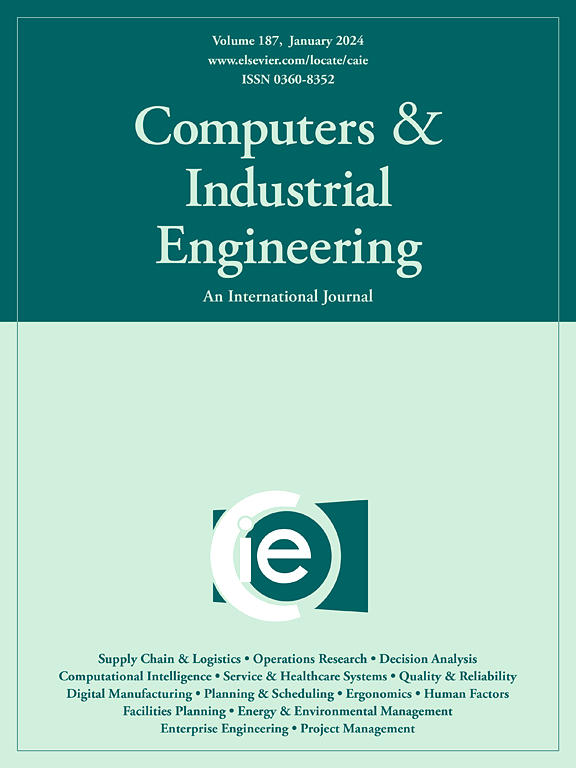Linking forward and backward product quality in a manufacturing/remanufacturing inventory system with price-quality-dependent demand and return rates
IF 6.7
1区 工程技术
Q1 COMPUTER SCIENCE, INTERDISCIPLINARY APPLICATIONS
引用次数: 0
Abstract
The concepts of remanufacturing and reusing products in a reverse supply chain have garnered significant attention in recent decades. Numerous studies have focused on creating frameworks to model and optimize manufacturing/remanufacturing strategies and inventory levels, accounting for forward and reverse flows. Economic Order/Production/Manufacture Quantity models have consistently provided a solid foundation for scholars to design and enhance closed-loop supply chains across various industries. However, one crucial aspect often overlooked in the literature is the initial quality level of the product and its relationship with the end-of-use quality of returns. Higher quality levels allow for extracting more value from returned items but also demand more investment and higher prices. This study presents a model that addresses the link between forward and reverse quality while ensuring cost-effectiveness. It models the impact of product quality and selling price on demand as observed in practice. It also considers an acceptable return period, aligning with what is commonly practiced in the industry by well-known companies. The findings emphasize the importance of linking forward quality with salvage value and indicate that disregarding this connection can lead to suboptimal strategies. Several numerical analyses and randomized simulations were conducted to explore the model’s behavior and the influence of key factors on the outcomes. The results indicate that producing at a quality level above the minimum standard is not only more environmentally friendly (thanks to increased returns and remanufacturing) but also tends to be more profitable in most cases. The developed model will aid decision-makers in developing optimal supply chain designs and identifying effective remanufacturing and reverse supply chain strategies.
将制造/再制造库存系统中的前向和后向产品质量与依赖于价格质量的需求和退货率联系起来
近几十年来,逆向供应链中的再制造和产品再利用的概念引起了人们的极大关注。许多研究都集中在创建框架来建模和优化制造/再制造战略和库存水平,考虑正向和逆向流动。经济订单/生产/制造数量模型一直为学者们设计和增强各行业的闭环供应链提供了坚实的基础。然而,在文献中经常忽略的一个关键方面是产品的初始质量水平及其与退货的最终使用质量的关系。更高的质量水平可以从退货中提取更多的价值,但也需要更多的投资和更高的价格。本研究提出了一个模型,在确保成本效益的同时,解决了正向和反向质量之间的联系。它模拟了在实践中观察到的产品质量和销售价格对需求的影响。它还考虑了一个可接受的回报期,与业内知名公司的普遍做法一致。研究结果强调了将远期质量与救助价值联系起来的重要性,并表明忽视这种联系可能导致次优策略。通过数值分析和随机模拟,探讨了该模型的行为以及关键因素对结果的影响。结果表明,以高于最低标准的质量水平生产不仅更环保(由于退货和再制造的增加),而且在大多数情况下往往更有利可图。所建立的模型将有助于决策者制定最优供应链设计,并确定有效的再制造和逆向供应链策略。
本文章由计算机程序翻译,如有差异,请以英文原文为准。
求助全文
约1分钟内获得全文
求助全文
来源期刊

Computers & Industrial Engineering
工程技术-工程:工业
CiteScore
12.70
自引率
12.70%
发文量
794
审稿时长
10.6 months
期刊介绍:
Computers & Industrial Engineering (CAIE) is dedicated to researchers, educators, and practitioners in industrial engineering and related fields. Pioneering the integration of computers in research, education, and practice, industrial engineering has evolved to make computers and electronic communication integral to its domain. CAIE publishes original contributions focusing on the development of novel computerized methodologies to address industrial engineering problems. It also highlights the applications of these methodologies to issues within the broader industrial engineering and associated communities. The journal actively encourages submissions that push the boundaries of fundamental theories and concepts in industrial engineering techniques.
 求助内容:
求助内容: 应助结果提醒方式:
应助结果提醒方式:


